Hull Zero Three Read online
Page 18
“I’m not sure I can,” Nell says. “You two talk to the hull one way, I talk to Ship Control another way. Why somebody couldn’t have integrated our knowledge is beyond my understanding.”
“We’ve got company,” Kim says.
One of the girls has returned. She’s working her way forward from the staging area, a bright red sash floating around her neck.
“We’ve found her,” the girl says, a big smile transforming her face. “She’s with our sisters. She will accept a meeting.”
We listen with something between skepticism and fascination. Mysteries on our sick Ship rarely turn out to be helpful. Mother is nothing if not a mystery—maybe the prime mystery, after Destination Guidance.
My twin seems more sanguine, but he leads with the obvious. “While you were away, we saved the hull and maybe the rest of Ship,” he says. “Nell can work some of the controls—and in time, maybe all the controls.”
The girl accepts this with complacent cheer. “Of course,” she says.
“You’re not in the least impressed?” I ask.
“You have done what you were chosen to do,” she says.
“Maybe,” I say, pulling closer on a cable, stopping an arm’s length away. “What’s Mother got to offer our little group that we don’t already have?”
“Love,” the girl says. She turns. “Now we will head aft.”
“Nobody with love in her heart would choose to make us,” Tsinoy says, breaking her concentration on the covered bow. “A lot of us have died—sometimes hundreds of times. As any sort of team, we’re a strategic, tactical, and even a logistical nightmare. We know so little, and whenever we think we’re about to learn something important or solve all the puzzles, we hit the most infuriating obstacles—head-on. Maybe love isn’t enough.”
This is the longest speech I’ve heard from the Tracker. Not to my credit, I’m still surprised that such sophistication and reason can be found within a corded mass of ivory and rubies and steel.
“What Tsinoy seems to be suggesting,” Kim says, ever the moderator, “is that we need persuading. Even from your mother, we need evidence.”
Nell moves in next. The girl tracks her with earnest eyes. “If Mother is capable of choosing us from the Catalog and having us birthed in another hull, then she has to have some connection with Ship Control. Maybe she should join us—up here, where we’re reasonably safe.”
Scandalized, the girl regards me sternly, then turns to my twin. “You two are Teachers,” she reminds us. “Mother chose you to lead and make decisions.”
“We all make decisions together,” I say. “And we’re happy to rotate the role of tiebreaker.”
After a pause for several seconds of reflection, the girl’s eyes widen and she asks, “Why assume you are safe here?”
We don’t have a good answer.
“What you mean to say is you are comfortable,” she adds. “And you believe you are taking charge.”
“Stop jerking us around,” Nell says tightly. “Tell us what’s going on, or what you think is going on. You’re part of the team, aren’t you? Act like it.”
The girl is unruffled by the spidery woman’s tone. For perhaps the first time—or perhaps not, but more forcefully—I’m made aware that what seems like a little girl is in fact anything but. She is as cool and calm as anything we’ve encountered in the hulls—and perhaps more frightening for that reason.
My twin seems more willing to go along. “Clearly, we’re not communicating our needs,” he says. “Yes, we’re comfortable—but we’re way beyond being scared by threats or dark implications. Is that clear?”
The girl nods.
“What message would you carry back to your mother to tell her we need reassurance, proof, communication before we risk our lives again? Nobody knows what lies aft. We haven’t been there.”
“I’ve been there, and so has my sister,” the girl says. “In fact, many of my sisters.”
“No threats?” Nell asks. “No out-of-control hull factors or… Killers?”
“No,” the girl says. “This hull is as safe as we’ve been able to make it.”
“You take credit for saving this hull…” Tsinoy offers.
The girl says, predictably enough, that Mother should receive the credit.
“You’re just one of Mother’s little fingers,” Nell says.
The girl nods again, still puzzled by our reluctance—and clearly unconvinced that we’re so stubborn we won’t eventually give in and comply with her request. Her command, I realize. Mother believes we owe her—and so do her little girls.
The panels choose this moment to open again, to Tsinoy’s intense interest. I can’t tell whether she’s delighted or not, but her pink eyes move forward, and then she pulls herself to the transparent ports and—for the moment—is lost in contemplation of the universe.
“Mother has fixed your view. The hull can still make repairs,” the girl says. “We are responsible for its functions.”
“Is Mother in the Catalog?” Nell asks. “Because nobody here seems to remember anyone remotely like her….”
The girl puts on an offended moue. “You have not seen her.”
“Can Mother open all of Ship’s memory and records to us?” Nell asks, on a roll.
“Not all,” the girl says. “Much has been lost or damaged. As you know.”
“You don’t know whether Mother will do this for us, do you?” Nell asks.
The girl shakes her head. In her way, she is doing her best to be honest, to be one of the team. But she’s still just a finger. A severed finger.
“You can’t communicate with Mother psychically, can you?” Kim asks.
The others look puzzled, but I know where he’s going.
“I do not know what psychically means,” the girl says.
“Can you talk to her with your thoughts?”
“No,” the girl says. “That is silly.”
“Honestly, I’m intrigued,” Kim says, rising and stretching. “I’d like to meet Mother and ask my questions directly. Anyone else?”
The girl has not considered the possibility we would split our team. “Mother wishes all—”
“Well, that isn’t going to happen,” Tsinoy says, turning away from the stars, the wisps of nebula—a shower of brilliant sparks from deflected dust. “I need to stay here. Nell needs to control the hull, in case we lose the shields again. Tomchin can join Nell in the control space. Maybe one Teacher can help Tomchin search the Catalog all over again. The rest of you—it’s up to you. Individually.”
Tsinoy’s assertion is met with silence. The girl’s features settle into a cold solidity. She does not look at any of us. This must be fury, I think.
“I’ll go,” my twin says. “Or…”
“No, you stay,” Nell says. “He’ll go.” She points at me. I have no idea what she’s up to, but the resonance between us is promising.
“I’m intrigued as well,” I say. Then, to my twin, “Besides, you’re older and wiser, more valuable to these fine people.”
He frowns, then gives in, as if avoiding any contest of manly courage. Or he does not want to make a fight of it. Overplay his hand. I have no idea why these suspicions are growing stronger. “All right,” he says.
We shake hands, then hug. It’s an awkward moment, self-respect dangerously close to self-love. But however much we may look, think, and act alike, we are clearly no longer the same. Affection is not any sort of metaphysical issue. He wants to go; I don’t. Not really. But I’ll go, and he won’t.
“How far aft?” Kim asks.
“To the hub,” the girl says.
Tsinoy is conferring with Nell. They both have their hands on the hemisphere.
“I’m not sure we have any idea what’s really happening,” Nell says. “There’s so much contradictory information.”
The girl looks unhappy.
“Destination Guidance might not have cut the shields after all,” Nell says. “When we started to combine the hu
lls, the drives shut down. They’re still off. We seem to be executing a turning maneuver. We’re shifting into a long-curve orbit.”
“What’s that mean?” I ask.
“Ship may be approaching the gravity well of a greater stellar grouping,” Tsinoy says. “We can’t see it. It’s behind an arm of the nebula. During such a maneuver, the shields temporarily switch off to reconfigure for the new angle of interstellar wind. They turn on again when the proper angle is reached.”
Nell adds, “The hulls need to be separated again to restart the drives. But given our present circumstances, if the drives resume, we’ll begin not just a course correction but also deceleration.”
“We’ll slow down?” Kim asks.
Nell says, “Ship might be responding to prior programming, not to our threats.”
“A destination has been chosen?” I ask. “Why didn’t Ship Control tell us?”
“Maybe it doesn’t want us to know. Maybe we’re being manipulated. I don’t know the answers.”
I’m still tingling with the shock of this potential revelation. A turning maneuver, rearranging the shields—that’s actually a viable alternate theory. “They weren’t trying to kill us—and we didn’t force them to back down?”
“No,” Tsinoy says.
“Then what the hell good are we, sitting up here, thinking we’re in charge?” I ask.
“Clearly,” Nell says, “we’ve got more research to do.” She looks at me and crooks a long finger. “Will you join me in Ship for a moment? Before you go, I need Kim to see something as well.”
“What about me?” my twin asks.
“One at a time,” Nell says.
I approach the hemisphere and lay my hands beside Nell’s. She gives me a long, puzzled look. “Someone in here knows you,” she says softly. “Both of you.”
We go in.
A few minutes later, we emerge. Kim goes next. My twin watches with apparent calm. Does he suspect? Then, Nell invites him into Ship. What she tells him or shows him there, I don’t know.
NEW WORLDS AFT
The journey is not dangerous, the girl says, but it is devious and may take a while. To that end, we pack a lunch and some extra clothes and water. Ship is adapting. There is hope that we can change things—if we are kept informed.
And that is our mission. To find the girl’s mother and learn as much as we can. There are no farewells. We simply take our supplies in gray bags and move aft from the tent-shaped chamber. Kim and I are not complacent—we do not believe there is safety anywhere, but I also do not believe the girl is leading us into a trap. We may have the same approach to differing agendas, but for now, agreement should be possible.
We climb into the hull’s cap chamber, which is immense beyond our previous experience. In Hull Zero One, behind the cap chamber, a single water tank had filled the center of the hull, but here, Kim and I are surprised to find six tanks, each as large or larger. Their huge “eyes” are filled with the hypnotic beauty of trillions of gallons of water, interrupted by narrow turquoise voids, smaller bubbles rejoining great ones. Placid. Dormant.
“Why six?” Kim asks. I have no answer—the girl has no answer. Our curiosity is not her concern. She guides us out to the perimeter of the cap chamber. Looking up, I notice a bump in the center of the vast bulkhead supporting the six tanks, what might be a round hatch or access point. I think this could be the entrance to a more efficient route down the center line of the hull, between the tanks, but one we are not taking.
The girl leads us to a corridor that circles around the tank cap. We echo along the corridor until we reach a control pylon, positioned at a junction with another corridor leading aft. The pylon supports a simple flat visual display. This is new to us—but not to the girl. This is her domain. With deft fingers, she calls up our present location, then a map of the spaces we will encounter moving down the length of the water tanks. We are still hundreds of meters below the skin of the hull. The hull, so far, has shown no signs of resuming its high rate of spin, for which I’m grateful. I feel no need of extra challenges.
The display reveals thousands of spherical chambers arranged in rows and clusters around the tanks, none smaller than a hundred meters across. “Forest balls?” I ask.
“Like that, but no,” the girl says.
“What, then?”
“I don’t have the words.”
Kim and I quirk our lips. It’s obvious this hull is different from the one we were birthed in—but why? The girl doesn’t have the words.
As in Hull Zero One, the corridors are lined with bands and radiances. Again, it seems these must be guides for factors—indicating the corridors were not meant primarily for human travel. Kim takes an interest in an oval radiance of black and green lines, about as wide as two of my hands—less than one of his. I wait for him as he runs his fingers over it. The girl, as always, moves ahead by ten or twelve meters, then pauses to allow us to catch up.
Kim shakes his head and we move on. “No factors,” he says. Brief but sufficient—we’ve gone some ways and have yet to encounter cleaners, retrievers, or any of the other peculiarities we met in Hull Zero One.
The girl has assumed her characteristic lotus.
“Why no factors?” Kim asks.
She unfolds and stretches. “It isn’t dirty here, and nobody’s dying.”
“Why not birth us here, then, where it’s clean and things won’t chase us?” Kim asks. His tone has an accusing edge. Big Yellow has always seemed remarkably together and calm, perhaps because of his obvious strength, or perhaps because those are simply innate qualities marked somewhere on his page in the Catalog.
The girl moves on. “I don’t know,” she calls back.
I think about asking if she’s the one who rescued me after my chilly birth, but if it doesn’t matter to her, then it doesn’t matter to me. Sentiment and memory are severely mismatched in our unbalanced and wretched world.
Odd how food and water and a clean body—and a few moments of rest—lead me into philosophy.
Kim touches another oval. “If we could read them, these would tell us where we are and where to go,” he says.
“Right,” I say. “Anything bubbling up from memory?”
“Not yet,” he says. “You?”
We’re making conversation, putting off the inevitable. We’re both reluctant to talk here about what Nell showed us. The girl’s hearing is remarkably acute.
“Well, I’d like to say these are orientation signs used by factors, but there are no factors.”
He snorts his humor. “What in the hell are we doing here?”
“Following,” I say.
“Away from food and water…” He pauses to frown intensely at another oval. “More of these, just around here. That could mean another intersection is coming up. I wonder if she can read them.”
I look for the girl but she’s way ahead, out of sight beyond a curve in the corridor. Suddenly, Kim pulls me close. “Nell tells me I have to watch you.”
I swallow. “I don’t blame her.”
“She thinks you’re the real deal… whatever that means.”
“Thanks,” I whisper.
“Did she tell you about the book in the netting?”
I nod and point to his big hands on my arms. “Looser, please.”
“She says you have little bumps on your head, but the other one doesn’t. You’re not identical.”
“I didn’t check him,” I say.
“Why would he hide his book in the egg? Why not just show it to us? You did, after all.”
“It’s probably in code,” I suggest, as if making an excuse.
“She figured it out.”
I hadn’t realized Nell was that quick. I feel like a little boy caught trying to hide a dirty secret—even though it isn’t me, and it isn’t my secret. “Oops,” is all I can say.
“She didn’t tell me if she read it all,” Kim says. “Just the part about looking for Mother, and making sure we agree to crunch Dest
ination Guidance. We all wanted that, didn’t we, at first? All but Tsinoy.”
“Yeah. But he wrote it down like an instruction. Like he was following orders. So… where did he get his orders?”
Kim relaxes his grip. “What else did Nell show you?”
The biggest discovery of all. I’m still not sure I believe it. “We carry a lot of Ship’s memory and programming inside us. Maybe more. We’re like safety storage—a biological backup. Ship is recovering memory from us each time we enter. Some of the parts that looked burned are growing back. We’re helping fill them in. Especially Nell and Tsinoy.”
“And me?”
“Not so much. Not yet. Nell doesn’t know where you fit in.”
“But she took your twin into Ship, as well as you. Wouldn’t you be the same?”
“I don’t know.”
“What does Ship need from him? What do you think he’s carrying?”
“I don’t know.” I feel uncomfortable coming to any conclusion about my twin. I’m still not in the clear myself. The way Kim looks at me. The way Nell seemed to be testing all of us.
The girl has doubled back and waits at a junction with another tunnel. I don’t feel comfortable talking about any of this in front of her.
I’ve lost any real sense of position. The corridor we’ve been following moves on for another ten meters, then comes to a rounded stop.
“Outboard,” the girl says, and pushes off from the floor, straight up the shaft.
We follow. Less than thirty meters beyond, we plunge into a warm, moist, shadowy volume of indefinite size. Kim grabs a loose cable, then wraps his ham fist around my ankle. As if responding to our presence, the volume suddenly illuminates. We have to shield our eyes against the brightness.
“You should have closed your eyes,” the girl says, a vague small blur close by.
“Thanks for the warning,” Kim says.
I peep out through my fingers. Details swim into view. We dangle for a moment on the outstretched cable, then Kim hands me down, and we brace on the lip of the shaft. I stay close, getting my bearings, and feel safer next to him.

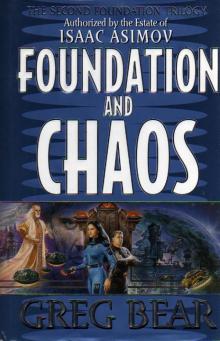 Foundation and Chaos
Foundation and Chaos Halo: Silentium
Halo: Silentium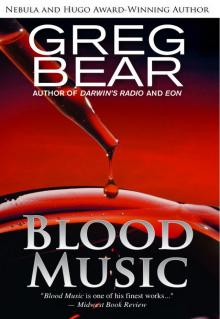 Blood Music
Blood Music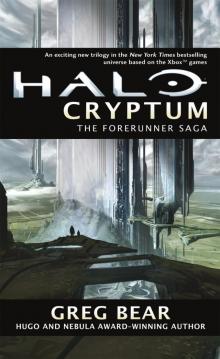 Halo: Cryptum
Halo: Cryptum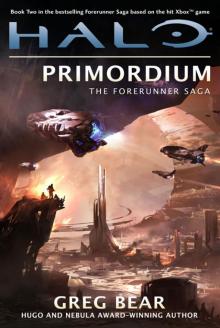 Halo: Primordium
Halo: Primordium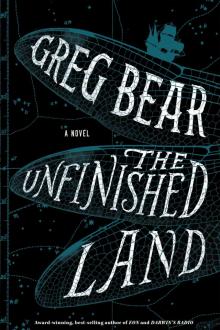 The Unfinished Land
The Unfinished Land Hardfought
Hardfought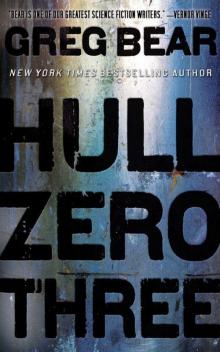 Hull Zero Three
Hull Zero Three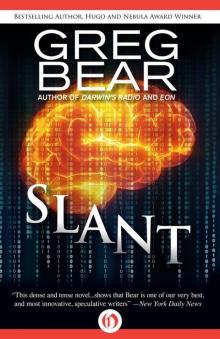 Slant
Slant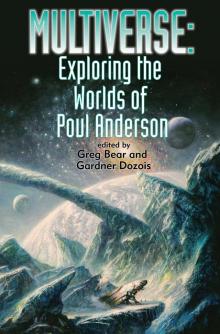 Multiverse: Exploring the Worlds of Poul Anderson
Multiverse: Exploring the Worlds of Poul Anderson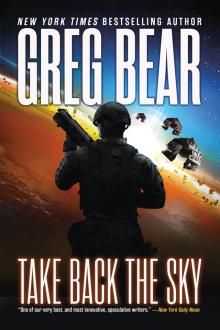 Take Back the Sky
Take Back the Sky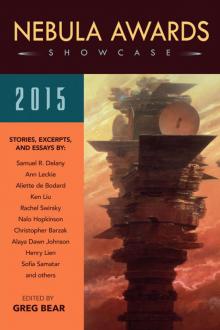 Nebula Awards Showcase 2015
Nebula Awards Showcase 2015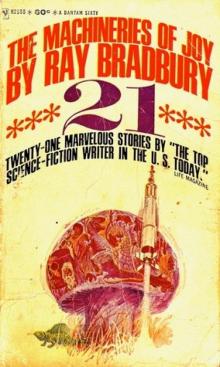 Machineries Of Joy
Machineries Of Joy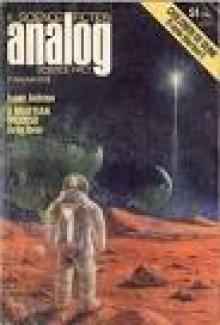 A Martian Ricorso
A Martian Ricorso Eternity
Eternity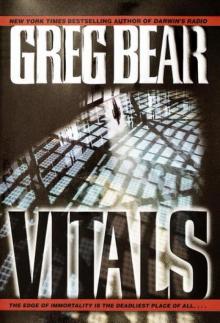 Vitals
Vitals The Infinity Concerto
The Infinity Concerto Beyond the Farthest Suns
Beyond the Farthest Suns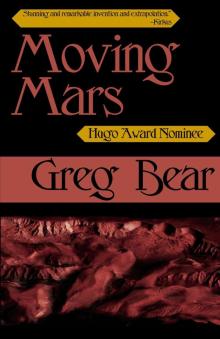 Moving Mars
Moving Mars Quantico
Quantico Darwin's Radio
Darwin's Radio Beyond Heaven's River
Beyond Heaven's River Star Wars - Rogue Planet
Star Wars - Rogue Planet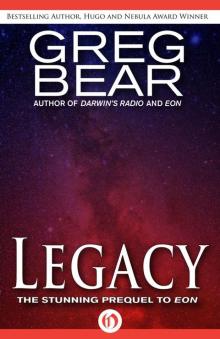 Legacy (Eon, 1)
Legacy (Eon, 1)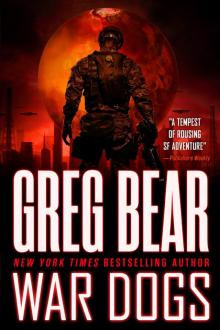 War Dogs: Ares Rising
War Dogs: Ares Rising Sisters
Sisters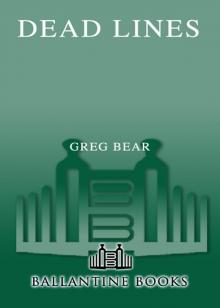 Dead Lines
Dead Lines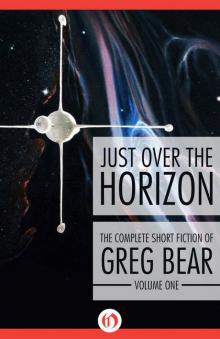 Just Over the Horizon (The Complete Short Fiction of Greg Bear Book 1)
Just Over the Horizon (The Complete Short Fiction of Greg Bear Book 1) Eon (Eon, 2)
Eon (Eon, 2) Venging
Venging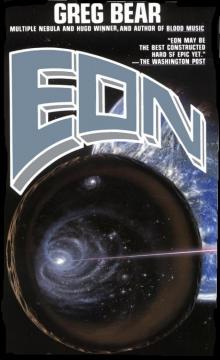 Eon
Eon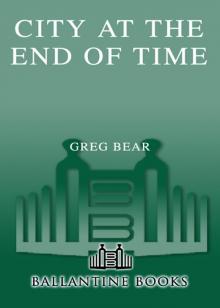 City at the End of Time
City at the End of Time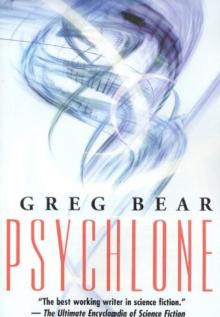 Psychlone
Psychlone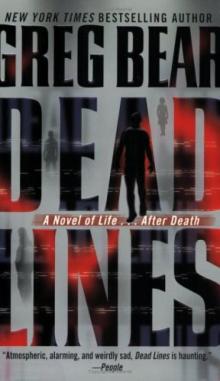 Dead Lines, A Novel of Life... After Death
Dead Lines, A Novel of Life... After Death Eternity (Eon, 3)
Eternity (Eon, 3) Cryptum
Cryptum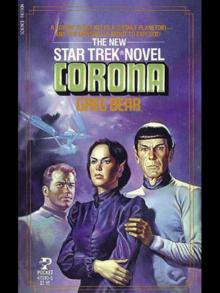 Corona
Corona Sleepside: The Collected Fantasies
Sleepside: The Collected Fantasies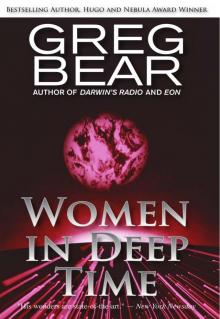 Women in Deep Time
Women in Deep Time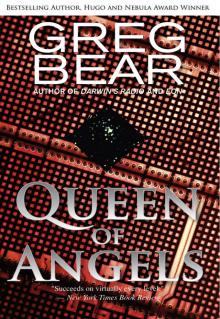 Queen of Angels
Queen of Angels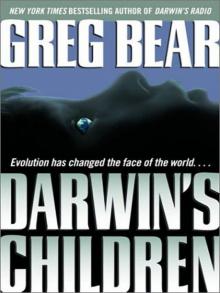 Darwin's Children
Darwin's Children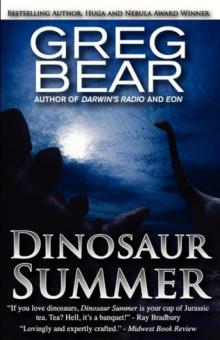 Dinosaur Summer
Dinosaur Summer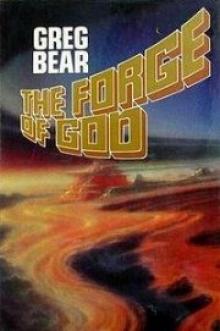 The Forge of God tfog-1
The Forge of God tfog-1 Foundation and Chaos f-9
Foundation and Chaos f-9 Star Wars: Rogue Planet
Star Wars: Rogue Planet The Forge of God
The Forge of God Mariposa
Mariposa Halo: Cryptum: Book One of the Forerunner Saga
Halo: Cryptum: Book One of the Forerunner Saga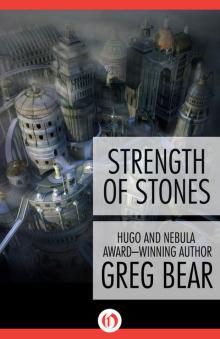 Strength of Stones
Strength of Stones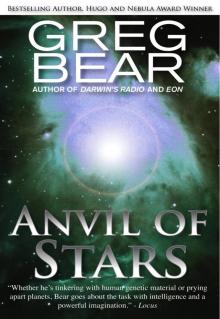 Anvil of Stars
Anvil of Stars B00AQUQDQO EBOK
B00AQUQDQO EBOK Anvil of Stars tfog-2
Anvil of Stars tfog-2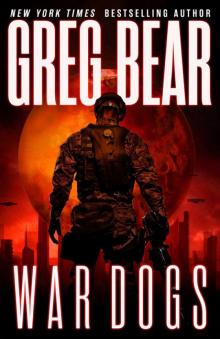 Ares Rising 1: War Dogs
Ares Rising 1: War Dogs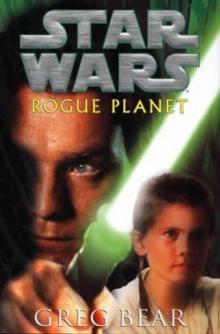 Rogue Planet (star wars)
Rogue Planet (star wars) The Machineries of Joy
The Machineries of Joy Far Thoughts and Pale Gods
Far Thoughts and Pale Gods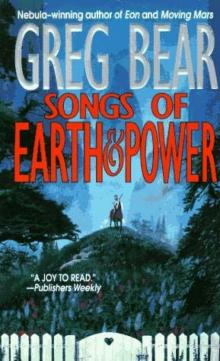 Songs of Earth and Power Omnibus
Songs of Earth and Power Omnibus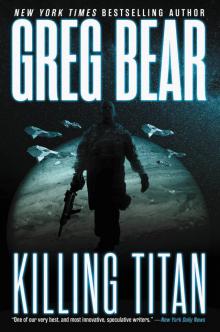 Killing Titan
Killing Titan Darwin's Radio d-1
Darwin's Radio d-1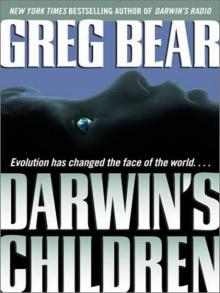 Darwin's Children d-2
Darwin's Children d-2